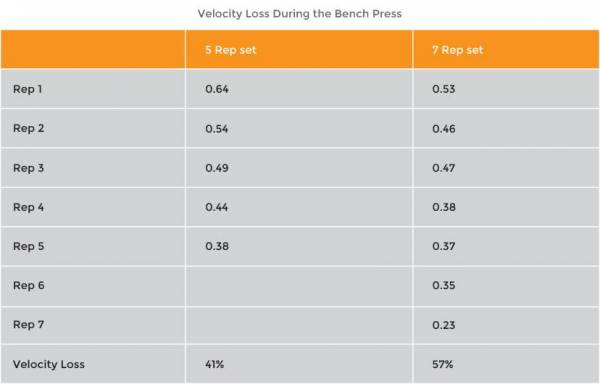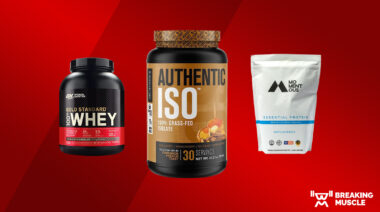If you’re reading this, you’re probably curious to know how you can use data to increase muscle size. Many of you may be familiar with VBT (velocity-based training) as a means to autoregulate training loads and provide visual feedback during speed and power sessions. But that’s not all velocity can do. There is good evidence that velocity can be effective in providing instant feedback during hypertrophy training sessions.
Let’s look at two ways we can use velocity data to promote muscle growth (and a third way that doesn’t require a monitoring tool).
Percentage-based loading isn’t always accurate.
1. Velocity-Based Loading
In theory, percentage-based loading is great. You test your one-rep max (1RM) and presto, you can pinpoint exactly what load to use based on a certain percentage. Unfortunately, percentages don’t stack up to reality. In reality, a successful lifter adjusts on the fly based on feeling. Less experienced lifters, though, will likely try to stick to the exact percentages and the exact 1RM that was tested eight weeks ago even if it’s not the best thing for their progress.
“Many coaches and athletes are using velocity to gain strength and power, but even at those high levels of sport, there are times when hypertrophy is important.”
Using velocity may just give you the objective insight you’re currently lacking. For certain exercises, the research is quite clear – there’s a high correlation (0.98) between a relative percentage load and velocity.1This means that if you want to train at 80% of your 1RM, there will be a corresponding velocity output.
This isn’t a fluke either. In one study, over 100 strength-trained subjects performed a 1RM bench press test while researchers measured their movement velocity. Take a look at Table 1. For each percentage you’ll notice an associated velocity output. Just to make sure this wasn’t due to chance, the researchers retested the subjects at a later date and there was no difference between the two sessions.

Table 1 – Relative Percentage Loads vs Velocity Outputs (González-Badillo & Sanchez-Medina 2010)
For those using velocity-based tools like the PUSH band, this is great news as it allows you to pinpoint exactly what velocity you should be working with depending on the relative load your trainer prescribed.
For example, say you performed a 1RM test (or an estimated test) for the bench press and it turned out to be 120kg. Now let’s say your coach has asked you to train between 75-80% (look at Table 2) of your 1RM – that load corresponds to 90-96kg. In week one, this may be the appropriate load, but what about weeks two, three, and four? Your 1RM will fluctuate and that 96kg may no longer be 80%.

Table 2 – Training Goals and Loading Parameters
So, let’s do this instead: Look at Table 1 again and find the velocity that corresponds to 75% and 80% – it’s 0.48 to 0.56. Now, when you perform your first working set and the first few reps are around the 0.7m/s mark, you’ll know it’s time to move up in weight. Simply adjust the load until you find the appropriate weight for that intensity and that session. Note: you must always look at the first few reps of a set, especially during a hypertrophy program where velocity will drop off across a set.
“Unfortunately, percentages don’t stack up to reality. In reality, a successful lifter adjusts on the fly based on feeling.”
Table 1 is a bit misleading, though, because it only reflects the bench press exercise. Each exercise will have a different velocity-load profile. That’s why you may have to create your own individualized profiles for your big lifts (until research catches up to those of us ahead of it). This can be done through a submaximal 1RM test using a velocity-based tool, which will allow you to create a load-velocity profile for any exercise.
2. Velocity Loss
Velocity loss is the percentage difference between the fastest rep of a set and the slowest. We know there are three key mechanisms for muscles to grow. One of these is metabolic stress. Research using velocity as an indicator of effort and fatigue shows us there are different ranges in velocity loss for different training qualities.2 For instance, if velocity loss is between 40-60%, the targeted training quality will be mostly hypertrophy. Conversely, if the velocity loss is less than 20-25%, the training focus would mostly fall under speed and power.
With velocity tracking, we can still ensure we’re getting enough of a stimulus to generate the desired training response without killing ourselves in the process. For example, aiming for a loss of 60% too often could spell disaster, while mixing in losses in the 40-45% range could be just right.

Table 3
Looking at the table above, you’ll notice that in the 7-rep set, the athlete was close to that 60% drop in velocity while in the 5-rep set, there was a 41% drop. In these two cases the absolute load was similar, but in the 5-rep set, the individual probably had 2-3 reps left in the tank. Even without going to failure, there is still a good training effect when aiming for the 40% mark instead of the 60% mark, and it may help your subsequent training bouts.
3. Volume
The biggest and strongest athletes all have one thing in common when it comes to their programs. High training loads. This means that monitoring volume is extremely important. There are various metrics that will allow you to monitor volume but my favorite is still volume load (or tonnage). To calculate this metric, all you need is basic multiplication skills:
VL = Reps x Sets x Load
Example: I perform a back squat for 3 sets x 5 reps at 100kg, 120kg, and 140kg. This case is a little trickier as you have to multiply the reps by each load and then take the sum:
100kg x 5 = 500kg
120kg x 5 = 600kg
140kg x 5 =700kg
Sum = 1800kg
Figure 1 provides an example of what volume load would likely look like over time. Quick tip: it’s impossible to expect to increase volume load lifted in a linear manner. That’s why you’ll see in the example that volume load has decreased in the last three weeks. This athlete was actually tapering (i.e. trying to peak for competition).

Figure 1 – Volume Load Across 16 Weeks
The goal would then be to add volume load over the course of the week, month, year, etc. Almost all sport scientists will agree this is crucial for increases in size.
Summary
Many coaches and athletes are using velocity to gain strength and power, but even at those high levels of sport, there are times when hypertrophy is important. Knowing exactly what loads to use based on a specific velocity and the drop in velocity across a set are two sure ways to promote muscle growth while avoiding overtraining.
And whether you have a velocity-based tool or not, monitoring volume through tonnage is simple and effective. The Eastern bloc countries were doing it before computers were invented, so I’m sure you and I can spruce up on our multiplication skills and try it as well.
More Like This:
- Velocity Based Training: Stop Guessing Your Weights and Reps
- Introductory Guide to Velocity Based Training
- Why You Should Never Hit a 1RM Again
- New on Breaking Muscle Today
References:
1. González-Badillo JJ, Sanchez-Medina L. “Movement Velocity as a Measure of Loading Intensity in Resistance Training.” Int J Sports Med 31: 347-352, 2010.
2. Sanchez-Medina L, González-Badillo JJ. “Velocity Loss as an Indicator of Neuromuscular Fatigue during Resistance Training.” Med Sci Sport Exerc 43: 1725–1734, 2011.
3. Izquierdo M, Ibañez J, González-Badillo JJ, Häkkinen K, Ratamess NA, et al. Differential effects of strength training leading to failure versus not to failure on hormonal responses, strength, and muscle power gains. J Appl Physiol 100: 1647–1656, 2006.
4. Sanchez-Medina L, Gonzalez-Badillo JJ, Perez CE, Pallares JG (2014) Velocity- and power-load relationships of the bench pull vs. bench press exercises. Int J Sport Med 35:
209–216. doi:10.1055/s-0033-1351252.
Photo 1 courtesy of Shutterstock.






